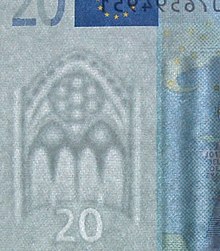20 euro note
| (European Union[1]) | |
|---|---|
| Value | 20 euro |
| Width | 133 mm |
| Height | 72 mm |
| Security features | Hologram, EURion, watermarks, raised printing |
| Material used | 100% pure cotton fibre |
| Years of printing | 2002–present |
| Obverse | |
 | |
| Design | Arch in Gothic architecture and map of Europe |
| Designer | Robert Kalina |
| Design date | 3 December 1996 |
| Reverse | |
 | |
| Design | Bridge in Gothic architecture |
| Designer | Robert Kalina |
| Design date | 3 December 1996 |
The twenty euro (€20 or 20€) note is one of the middle value euro banknotes and has been used since the introduction of the euro (in its cash form) in 2002.
Design
The ten euro note is the second smallest at 133x72mm with a grey colour scheme.
All bank notes depict bridges and arches/doorways in a different historical European style; the ten euro note shows the Classical era (between the thirteenth and fourteenth century CE). Although Robert Kalina's original designs were intended to show real monuments, for political reasons the bridge and art are merely hypothetical examples of the architectural era.
Like all euro notes, it contains the denomination, the EU flag, the signature of the president of the ECB (and the initials of said bank in different EU languages, a depiction of EU territories overseas, the stars from the EU flag and various security features as described below.
Security features

The twenty euro note is protected by a hologram stripe, reflective glossy stripe, a EURion constellation, watermarks, raised printing, a security thread, matted surface, perforations, see through number, barcodes and a serial number. The printer code is located in the 9 o'clock position star.
Changes
There has so far only been one series of euro notes, however a new series similar to the current one is to be issued from 2011. The initial issue of notes bears the signature of the first president of the European Central Bank, Wim Duisenberg, who was replaced on 1 November 2003 by Jean-Claude Trichet, whose signature appears on subsequent issues.
Notes
- ^ Eurozone and Institutions only
